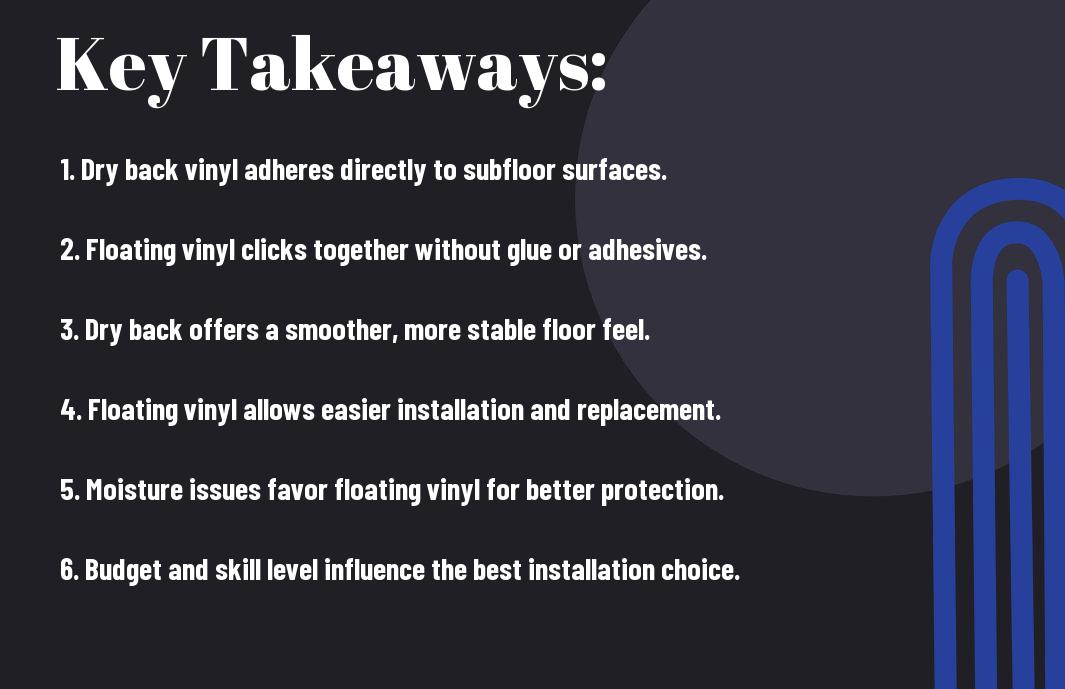Many homeowners find themselves choosing between dry back and floating vinyl flooring as they consider their next home improvement project. Each installation method offers unique advantages and drawbacks that can significantly influence the look, feel, and longevity of your flooring. Understanding the differences between these two options can help you make an informed decision that aligns with your needs and preferences. In this post, we will explore both installation methods to help you determine which is the best fit for your space.
Assessing Your Space: Key Factors in Choosing Flooring
Your space presents unique challenges and benefits that influence flooring choices. Important factors to consider include:
- Room size and layout
- Activity levels and furniture placement
- Moisture levels and climate conditions
- Subfloor material and existing flooring type
- Personal style and desired aesthetics
After evaluating these factors, you can make a more informed decision about the type of vinyl flooring that fits your needs best.
Room Function and Activity Levels
The purpose of each room significantly impacts your flooring decision. High-traffic areas like living rooms or hallways benefit from durable flooring that can withstand wear and tear. In contrast, quieter spaces such as bedrooms may prioritize comfort and aesthetics. Consider how often each room will be used and how many people, pets, or activities will take place there.
Existing Floor Conditions and Subfloor Requirements
Your current flooring situation will shape your options. Ensure the existing floors are clean, dry, and level before installation. For floating vinyl, a smooth surface is necessary for proper performance, while dry back requires a suitable adhesive bond with the underlying material. If there are any defects in the subfloor, correcting these issues beforehand is important.
Addressing existing floor conditions requires an assessment of the current state of your subfloor. Any unwanted variations, such as dips, cracks, or moisture issues can lead to complications down the line. In some instances, you may need to install an underlayment to provide a stable base or to help with sound insulation. Being thorough with this assessment saves time and potential headaches during and after installation.

The Mechanics of Dry Back Installation: Pros and Cons
Dry back installation offers a reliable option for laying vinyl flooring, involving securing planks to the subfloor with adhesive. This method can lend itself to durability but also comes with some challenges that you should weigh carefully.
Pros and Cons
| Pros | Cons |
|---|---|
| Strong bond to the subfloor increases stability. | Installation requires more time and skill. |
| Less chance of shifting or movement. | Potential for lengthy drying times with adhesives. |
| Wide selection of styles and textures available. | Demands a level subfloor for best results. |
| Ideal for high-traffic areas. | Removal can be labor-intensive and messy. |
| Compatible with various underlayments for added comfort. | Can be more expensive due to adhesive costs. |
Installation Process and Materials Needed
Preparing a dry back installation requires specific materials, such as high-quality adhesive, a utility knife for cutting, and a roller to ensure proper adhesion. You’ll first want to clean and level your subfloor, then apply the adhesive according to the manufacturer’s guidelines. Once it’s set, you can lay down the vinyl planks, ensuring a tight fit and alignment.
Durability and Maintenance Considerations
Your dry back vinyl flooring is designed for longevity, particularly in homes with heavy foot traffic. It holds up well against daily wear and tear, allowing for easy cleaning and occasional maintenance to keep it looking fresh.
Compared to other flooring options, dry back vinyl flooring can withstand scratches and dents, making it a practical choice. Regular maintenance includes sweeping or vacuuming to remove dirt, along with occasional mopping using a gentle cleaner specifically formulated for vinyl. While laminate or tile may chip, dry back flooring resists these issues due to its robust adhesive bond to the subfloor. With a commitment to proper care, your flooring can maintain its aesthetic appeal and structural integrity for many years, providing you with both style and functionality in your space.
Floating Vinyl Flooring: The Ease of Installation
Floating vinyl flooring simplifies the installation process, allowing you to transform your space with minimal effort. Without the need for glue, nails, or staples, you can quickly and efficiently lay down planks that click together with ease. This method not only saves time but also reduces the likelihood of mess during installation compared to traditional options.
Snap-Together Technology and Its Benefits
Snap-together technology is at the heart of floating vinyl flooring, allowing planks to interlock seamlessly. This innovative design eliminates the need for adhesive, making the installation process user-friendly and efficient. You can easily replace individual boards if needed without disturbing the surrounding flooring, saving you time and cash in the long run.
Performance in Various Environments
Floating vinyl flooring excels in diverse environments, from kitchens and bathrooms to living rooms and basements. Its water-resistant properties make it a smart choice for moisture-prone areas, while its durability stands up to heavy foot traffic and impact. The reduced thermal transfer also ensures comfort underfoot, whether in colder or warmer climates.
This versatility can be demonstrated in various applications. In kitchens, where spills may occur frequently, floating vinyl’s water-resistance protects the subfloor and minimizes the risk of mold and warping. In basements, it can withstand humidity, alleviating concerns about moisture damage. Additionally, installation over radiant heating systems allows for evenly distributed warmth, enhancing your home’s comfort. Each of these features showcases why floating vinyl flooring is an exceptional option for almost any room in your home.
Comparing Cost and Time: Financial Implications of Each Method
| Installation Method | Financial Considerations |
|---|---|
| Dry Back Vinyl Flooring | Often lower material costs but requires more labor and additional tools, leading to higher installation expenses. |
| Floating Vinyl Flooring | Higher material costs can balance against lower installation costs, providing a more cost-effective solution in some scenarios. |
Upfront Costs and Long-Term Investments
Dry back vinyl flooring usually presents lower material costs, making it initially appealing. However, with increased labor needs and installation expertise, your upfront investment may climb higher. In contrast, floating vinyl might come with a higher price tag for the materials, but the ease of installation can often offset these costs over time, making it an attractive long-term investment.
Timeframe of Installation and Impact on Workflow
Floating vinyl flooring typically offers quicker installation than dry back options, allowing you to reduce downtime significantly. As you consider your project, the choice of flooring can influence how quickly your space can be ready for use, affecting overall productivity.
Expedited installation times mean that floating vinyl flooring can often be completed within a day or two, depending on the area size. This method allows you to utilize your space faster, which is particularly beneficial for businesses that cannot afford prolonged disruptions. Dry back installations, while more durable, may take several days due to adhesive setting times and surface preps, potentially affecting your ongoing operations or your ability to enjoy the space immediately. Choosing the right type based on your schedule can yield notable benefits for your overall workflow.
Future-Proofing Your Home: Long-Term Performance and Trends
Choosing the right type of flooring not only affects immediate aesthetics and comfort but also impacts your home’s long-term performance. Both dry back and floating vinyl options offer durability, but varying maintenance needs and installation methods can influence their lifespan. Predicting future trends in interior design, sustainable practices and technological advancements in materials suggests that investing in quality flooring today could save you money and hassle in the years to come.
Environmental Impact and Sustainability
As sustainability becomes a focal point in home improvements, your flooring choice plays a pivotal role in minimizing environmental footprints. Opting for vinyl flooring that uses recycled materials can significantly reduce waste while ensuring quality and style. Additionally, many brands offer eco-friendly options that meet stringent environmental standards, appealing to DIY enthusiasts and environmentally conscious homeowners alike.
Market Trends and Resale Value Considerations
Flooring trends can alter the perceived value of your home. Vinyl flooring, particularly styles that replicate hardwood or stone, is gaining traction among homebuyers. Its appeal lies not only in aesthetics but also in ease of maintenance and longevity. Properties featuring modern, well-installed flooring can command higher prices on the market, making your investment worth every penny.
Recent data shows that homes with luxury vinyl flooring often sell for 5-10% more than those with traditional carpeting or outdated materials. The shift towards eco-friendly and stylish options in home design is prompting buyers to seek out sustainable flooring solutions. A well-chosen vinyl flooring not only enhances your living space but can significantly boost the resale value, enabling you to recoup your investment when it’s time to sell. Investing in quality materials reflects well in your property’s overall appeal, drawing potential buyers to your home in a competitive market.
Conclusion
Summing up, choosing between dry back and floating vinyl flooring comes down to your specific needs and installation preferences. If you prioritize stability and don’t mind using adhesive, dry back may be your best bet. Conversely, if you value easier installation and the ability to change your flooring in the future without hassle, floating vinyl could be ideal. Assess your environment, budget, and long-term plans to determine which method aligns best with your lifestyle and flooring goals.


